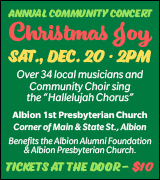Community Coalition program on April 4: ‘How far have we come since Selma?’
Press Release, Community Coalition for Justice
ALBION – On Thursday, April 4, at 6:30 p.m. the Community Coalition for Justice is bringing Sister Barbara Lum to the Hoag Library.
Sister Barbara is a nurse practitioner and belongs to the Sisters of St. Joseph order. Included in the communities that Sr. Barbara has served the underserved are Selma, Alabama, and for 59 years, Elmira and Rochester, New York.
During Sister Barbara’s nine-year stint in Selma, the infamous march that came to be known as “Bloody Sunday” racked the city. Sister Barbara was a participant in events that led up to, and surrounded, the march and will talk about her experiences.
“Bloody Sunday” occurred on March 7, 1965. An estimated 525 to 600 civil rights marchers left Selma and headed on a 54-mile journey to the state capital in Montgomery, Alabama. The march was organized by the Selma Voting Rights Campaign (in Selma, voting rolls were 99% White and 1% African American) and led by John Lewis (who later became an esteemed member of the U.S. House of Representatives) and the Reverend Hosea Williams.
The peaceful protest went according to plan until the marchers tried to cross Montgomery’s Edmund Pettus Bridge. There they were confronted by a cadre of state troopers and posse of white men who were deputized that morning in anticipation of the march.
State troopers began shoving the unarmed demonstrators, knocking many to the ground and beating them with batons. Another detachment of troopers fired tear gas and mounted troopers charged the crowd on horseback. Many of the demonstrators sustained injuries – one of the injured was John Lewis, who suffered lacerations as well as a skull fracture. He later credited the nurses who tended to him, including Sister Barbara, for saving his life. There were 17 marchers hospitalized and 50 marchers were treated for lesser injuries.
The televised images of the attack reached American and international audiences and roused support for the Selma Voting Rights Campaign. The persistence of the protesters and the public support associated with the marches (including “Bloody Sunday”) led Congress to pass the Voting Rights Act of 1965. It was signed into law by President Lyndon B. Johnson on August 6, 1965.
Sister Barbara remembers a young friend and patient by the name of Jimmie Jackson. He was admitted to the hospital February 18, 1965 after being beaten and shot by police while he was defending his mother at a lunch counter. “Each day he’d say, ‘Sister, don’t you think this is a high price to pay for freedom?’”
He died a few days later, in part, sparking the march of March 7, 1965. “I think that the high price for freedom (that Jimmie Jackson spoke of 59 years ago) isn’t finished (being paid) yet,” said Sister Barbara.
She has two local connections. She had grandparents who lived in Waterport. And, she was in the Nazareth College Class of ’58 with Margaret Furino Golden, past member and president of the Swan (now the Hoag Library) Library Board.
There will be a questions and answer period after the presentation. Light refreshments will be provided.
The Community Coalition for Justice includes the Albion Betterment Committee, Pullman Universalist Church, Hoag Library, People Embracing Diversity and the Social Justice Committee.



































































